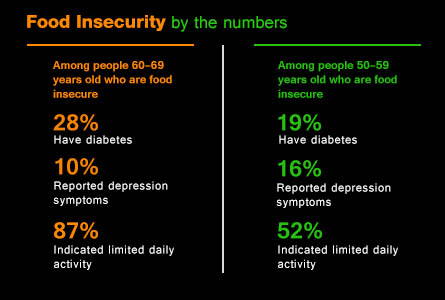The information presented on this page may be dated. It may refer to situations which have changed or people who are no longer affiliated with the university. It is archived as part of Mississippi State University's history.
Food insecurity impacts 8.5 percent of adults age 65 and older in the U.S. That percentage climbs to 12.3 percent in Mississippi, the state with the greatest number of older adults who experience some level of food insecurity.
David Buys, MSU researcher in the Mississippi Agricultural and Forestry Experiment Station and health specialist with the MSU Extension Service, recently authored a chapter about food insecurity and older Americans in the third edition of the "Handbook of Clinical Nutrition and Aging" published by Humana Press. The book is used in advanced training of physicians and other healthcare professionals.
The chapter discusses how food insecurity impacts public health.
Defining food insecurity
"The World Health Organization, or WHO, defines food security as having enough safe, nutritious food to maintain an active, healthy life," Buys said. "According to WHO, availability, access and use are the three pillars that comprise food security."
Buys said that means good, nutritious food has to be available for a person to access and an individual must know how to use the food for nourishment.
Food insecurity isn't just about hunger; it encompasses hunger, malnutrition, under-nutrition and over-nutrition.
"Food insecurity really has two sides: malnutrition and over-nutrition," Buys said. "The obesity epidemic prevalent throughout the U.S. and right here in Mississippi may be a symptom of food insecurity. When people don't have the financial resources to buy healthy foods they may buy what's available in their price range."
Buys explained food insecurity as a lack of nutrition as opposed to lack of food. He along with Julie Locher, his former colleague from the University of Alabama at Birmingham, coauthored the chapter.
"This particular chapter is upstream," Buys said. "A lot of the chapters are very clinical, biological and physiological in nature, but this chapter discusses the public health implications of the issues associated with food insecurity."
Health implications
The health implications of food insecurity in older adults are considerable, specifically for those who have been admitted to the hospital for treatment of chronic conditions such as diabetes, hypertension and hyperlipidemia. Buys said food insecurity increases these individuals' chances of returning to the hospital.
"Poor nutrition is independently associated with hospital readmissions," said Buys. "Older adults who are nutritionally at risk and who have been hospitalized are likely to return to the hospital within 30 days. In many instances, a patient enters the hospital, they lose their appetite, and when they return home, they don't bounce back to their previous eating habits like a younger adult may. That can put the patient in a downward spiral of decline."
Interventions and challenges
Interventions discussed in the chapter include home-delivered nutrition services, one of which is the well-known Meals on Wheels program. That program and others like it fed 145 million meals to 880,000 older adults in 2010. An increase in requests for home-delivered meals jumped 78 percent from 2007 to 2010. The chapter indicated the increase in need is critical since many who are eligible are those considered most at risk for food insecurity and poor health outcomes.
Buys said it can be difficult to quantify the effectiveness of interventions such as Meals on Wheels compared with other programs that address food insecurity in younger populations. He compares the program to the USDA's special supplement nutrition program for Women, Infants and Children, or WIC.
"WIC has shown for every dollar invested in the program, there is more than a $4 return on that investment. There hasn't been a similar evaluation of Meals on Wheels and it is because of the way the money is distributed," Buys said. "WIC is administered in a very systematic way and Meals on Wheels is administered in a variety of ways. While WIC is administered state by state, Meals on Wheels can be administered by state, city, county or community."
Buys said the difference in distribution can make it difficult to highlight the Meals on Wheels program's effectiveness and obtain additional funding.
"It's sometimes a challenge to lobby Congress for continued funding for programs like Meals on Wheels because we don't have the strong evidence base that's it is effective," Buys said. "We know intuitively that it is important but we can't say what kind of return on investment we are getting."
The next chapter
In addition to the chapter, Buys strives to inform stakeholders on the issue of food insecurity among older Americans through publications and ongoing research.
Buys teamed with Locher again as coeditor of a special issue of the Journal of Nutrition and Gerontology and Geriatrics focused on home and community-based nutrition services due out this spring.
Currently, Buys is conducting research on programs for people returning home from the hospital.
"I am working on two projects for patients being discharged from the hospital," Buys said. "One is a project in Birmingham where we've partnered with a nonprofit organization evaluating the feasibility of delivering meals to older adults after discharge; it is a randomized control trial, which is the gold standard of research. The other project is in partnership with Morrison Healthcare evaluating frozen meals at discharge. We have begun one site for that project and hope to expand it to Starkville, at OCH Regional Medical Center, in the near future."
In the first trial, researchers deliver three meals a day for 10 days to discharged patients in their homes. In the second trial, they provide 10 days' worth of frozen meals upon discharge.
While people should be motivated to act out of compassion and help satisfy a need, Buys said it's important to understand that hospital readmission rates associated with food insecurity are a drain on healthcare resources as well.
"If you aren't motivated out of consideration for fellow mankind, it helps to consider food insecurity in pure economic terms," Buys said. "Think about the bottom line and think about what this does to our Medicare dollars. If someone doesn't have the money, the physical means to drive to the store or whatever the case may be, it impacts not only that individual's food security level, but the health and wealth of the entire community."
If someone doesn’t have the money, the physical means to drive to the store or whatever the case may be, it impacts not only that individual’s food security level, but the health and wealth of the entire community.
David Buys
Behind the Science

David Buys
Assistant Extension and Research Professor
Education: B.S., Sociology, Mississippi College; M.S., Sociology, Auburn University; M.S.P.H., Epidemiology; Graduate Certificate, Gerontology; Ph.D., Medical Sociology, University of Alabama at Birmingham; Postdoctoral Fellowship, Health Services and Outcomes Research, University of Alabama at Birmingham
Years At MSU: 1
Focus: Life-course health education programming, nutrition and aging
Passion At Work: My balance of MAFES and Extension responsibilities gives me a wonderful opportunity to conduct public health-related research that I enjoy while also applying research through Extension programming in a way that makes a real difference in individuals’ lives.


